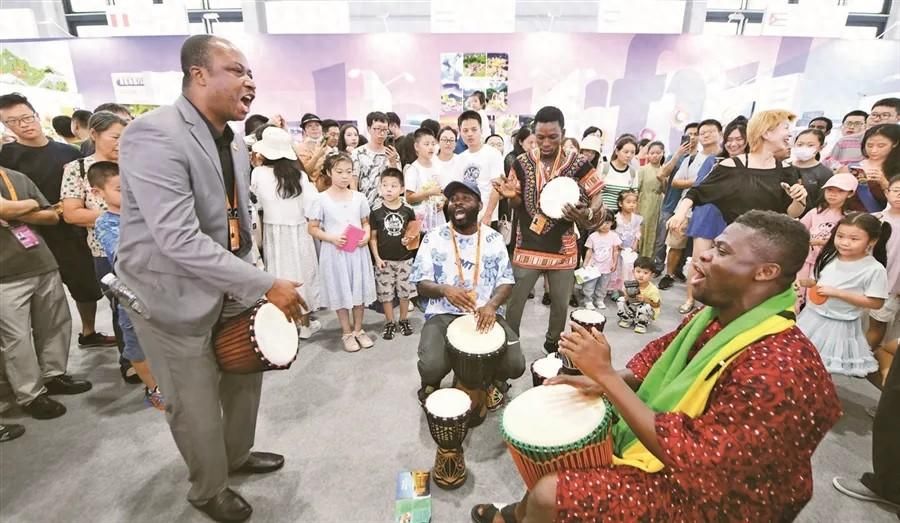共建“一带一路”倡议——全方位开放的“引领版”
BRI:A Leading Version of All-Around Opening Up
秋平
Qiu Ping
在新时代,中国把共建“一带一路”作为对外开放和对外合作的管总规划,推动形成陆海内外联动、东西双向互济的全面开放格局,建设更高水平开放型经济新体制,培育国际经济合作竞争新优势。
In the new era which began in 2012, China has taken the Belt and Road Initiative (BRI) as the overarching design for opening up and international cooperation. In doing so, it has created a comprehensive framework for opening up with links running eastward and westward across land and over sea, established new systems for a higher-standard open economy, and built up new strengths in international economic cooperation and competition.
促进沿海与内陆协调开放。共建“一带一路”作为开放发展的重大举措,与京津冀协同发展、长江经济带发展、粤港澳大湾区建设等区域重大战略有机结合,提升了开放的整体性、协同性。
The BRI has helped better coordinate the opening up of coastal and inland regions. As a major move for both opening up and development, the BRI has been seamlessly integrated with major development strategies for Chinese regions, such as the Beijing-Tianjin-Hebei region, the Yangtze Economic Belt, and the Guangdong-Hong Kong-Macao Greater Bay Area, facilitating opening up that is more comprehensive and better coordinated.
10年来,中西部地区发挥自身优势,积极融入“一带一路”建设,开放水平显著提升,从开放的“后卫”变成“前锋”。2013—2022年,中西部地区外贸占全国比重从13.5%提升至19.2%,对外投资占比从7.8%提升至14.7%。
Over the decade, the central and western regions have leveraged their strengths to integrate themselves into the process of Belt and Road development, significantly raising their level of openness and transforming themselves from rearguards to front runners in this process. From 2013 to 2022, the share of foreign trade of the central and western regions increased from 13.5% to 19.2%, while their share of foreign investment rose from 7.8% to 14.7%.

- Staff members perform at the exhibition booth of the Ghanaian embassy in China during a cultural exhibition of countries along the Belt and Road at the 2023 China International Fair for Trade in Services. The exhibition, which included special performances, cultural introductions, and passport stamping activities, showcased the cultural charm of BRI countries. PHOTO BY XINHUA REPORTER JU HUANZONG
优化传统与新兴市场布局。共建“一带一路”助力中国在巩固传统市场的同时,开拓新兴市场,增进了与金砖国家、东盟、中东欧、非洲、拉美等合作,优化了全球市场布局。2022年,中国对东盟贸易额占中国外贸比重达到15.5%,东盟地区连续三年成为中国第一大贸易伙伴。
The layout of Chinese trade and investment in traditional and emerging markets has also been improved. The BRI has helped Chinese enterprises consolidate traditional markets while venturing into emerging ones. China has enhanced cooperation with the countries of BRICS, ASEAN, Central and Eastern Europe, Africa, and Latin America, thus improving its global market layout. In 2022, China's trade with ASEAN accounted for 15.5% of its total foreign trade, making ASEAN China's top trading partner for three consecutive years.
推动制度型开放。过去中国主要是商品和要素流动型开放,现在更多转向规则、规制、管理、标准等制度型开放。在有条件的自由贸易试验区和自由贸易港试点对接国际高标准推进制度型开放,在此基础上,加快全面试点对接国际高标准经贸规则的先行先试工作。10年来,自由贸易试验区大幅缩减外资准入负面清单,由190项缩减到27项,制造业条目已归零。
China has also advanced institutional opening up. In the past, opening up was largely limited to flows of commodities and production factors. Now however, it is being oriented more toward institutions, covering rules, regulations, management, and standards. In pilot free-trade zones and ports with the right conditions, China has been piloting institutional opening up in line with high international standards. On this basis, China has accelerated comprehensive trials to align with high-standard international economic and trade rules. Over the past decade, the negative list for foreign investment access in pilot free trade zones has been significantly downsized, falling from 190 items to 27, with manufacturing items on these negative lists dropping to zero.
中文责编:郝遥
英文责编:蒋雯燕
英文审校:王翠芳 聂悄语
监制:于波 岳劲松
友情提示
本站部分转载文章,皆来自互联网,仅供参考及分享,并不用于任何商业用途;版权归原作者所有,如涉及作品内容、版权和其他问题,请与本网联系,我们将在第一时间删除内容!
联系邮箱:1042463605@qq.com